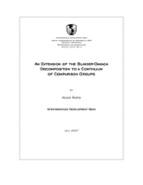An Extension of the Blinder-Oaxaca Decomposition to a Continuum of Comparison Groups
Date
Jul 2007
This paper proposes an extension of the Blinder-Oaxaca decomposition from two to a continuum of comparison groups. The proposed decomposition is then estimated for the case of racial wage differences in urban Peru, exploiting a novel data set that allows the capturing of mestizaje (racial mixtures).




